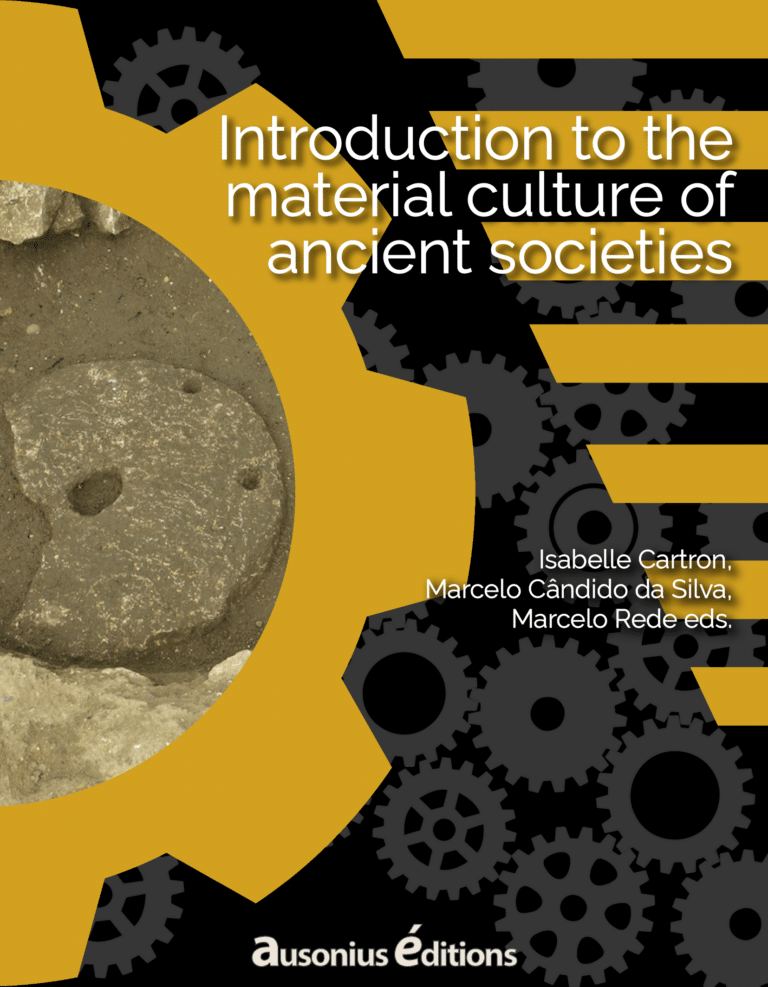The structural weakness of States in the High Middle Ages explains the importance of social ties. This fact also justifies the central place of the notion of reciprocity, the real engine of social relations. These observations correspond to the model identified by anthropologists and called the “gift-exchange”. This system makes it possible to treat all forms of transfer of goods (including individuals) as a whole, without necessarily distinguishing different motivations between commercial exchange, booty/ransom, religious donation (alms or pro remedio anima donations), dowries and dowers or judicial compositions (wergeld). This gift-exchange, also called “gift and counter-gift”, offers archaeologists and historians of early medieval societies the possibility of linking practices opposed by the classical economic model. Indeed, from the perspective of the “orthodox” economy, the objective of social actors is the search for profit, with commercial exchange or trade as the main vector. The rest is seen as coerced or irrational. The rest is seen as coerced or irrational. Western societies between the 6th and 11th centuries cannot fit into this framework, forged during the first globalization during the 18th century. The goal sought by these human groups is not profit but balance, balance between families, balance between individuals. This notion is the most likely to guarantee social peace, in a world where the place of honour is paramount. However, honour societies are violent societies, where the role of central authorities is to negotiate through rites and rituals to maintain peace or simply limit violence. This requires the definition of standards of behaviour, which will set the limit between legitimate actions and those that will be rejected in the camp of transgression.
The gift economy
In the ideal type defined by Bronislaw Malinovski, Marcel Mauss and Philip Grieerson (Malinovski, 1922; Mauss, 1999; Grieerson, 1959), the gift-exchange imposes three obligations, that of giving, receiving and giving back. Giving back, however, does not mean giving back a good of the same value, but often a superior gift that triggers a new cycle. There are therefore unequal exchanges, when the obligor cannot maintain reciprocity. Indeed, balance does not mean equality. In this sense, the gift-exchange contributes to the reaffirmation of hierarchies, by maintaining the social prestige of the elites. Because the obligated by contracting impossible moral debts, find themselves in a position of dependence in relation to the donor. Thus, according to Pierre Bourdieu, giving is not only a way of sharing what one has, but also of fighting with what one has (Bourdieu, 1980; Godelier, 1996).
Things to give and things to keep
In this model, we understand that it is not possible to give everything away, because some wealth has too great a symbolic value. Indeed, there are inalienable goods intended to transmit and root in time identities and differences between individuals and groups. These elements have intangible characteristics, play a role in the definition of social identity by providing their possessor with additional legitimacy. One thinks first of all of the symbols of power, particularly royal insignia or regalia (crown, sceptre, throne, etc.). The exercise of local power is also ritualized. Thus, the episcopal function results in the wearing of the ring and the crosier. For the count, the possession of a royal diploma and the wearing of the cingulum or cross-belt carrying the sword, marks the proximity to the prince and therefore the legitimacy to exercise this office. In the Frankish world from the second half of the 7th century, the handing over of arms (mainly the long sword) became a crucial moment in the life of the young nobleman, who thus fully took his place in society. Similarly, the laying down of arms on the altar, like the tonsure during a monastic conversion, marks the exit from the lay world and the change of order. Goods related to the sacred are also the subject of special attention. These can be relics, preserved in the form of pieces of jewellery, or entire churches, the possession of which is the tangible mark for societies of the High Middle Ages of the link between an aspect of the divinity and a family group. Buildings can be owned collectively and serve as necropolises for the family, allowing at the same time to anchor its power in a specific place. This phenomenon is particularly visible in Gaul at the end of the 7th century and during the first half of the 8th century, in the movement of foundation of female monasteries by the elites. The Carolingian sovereigns made no mistake in systematically getting their hands on these ensembles to transform them into royal abbeys.
This capacity to give an object by transforming it into a symbolic good is the mark of a power of the highest level, since it presupposes the manipulation of the sacred and creates an asymmetrical relationship with the obligated. Thus, from the end of the 6th century, Pope Gregory the Great developed the practice of the “keys of Saint Peter”, relics of contact, which were distributed in all the kingdoms of the post-Roman West to certain great personages to mark their spiritual filiation with Rome. Similarly, in the Scandinavian world, the treasures given by a king to his konungr (the local sub-kings) had to be kept, because they became the materialization of their status.
Gift – exchange and government
The royal treasury was therefore something quite different from a simple accumulation of material wealth. It was one of the emblems of royalty, which had to be ritually shared between the surviving sons during successions. In 614, Chlothar II reunited the Regnum Francorum – the kingdom of the Franks – by collecting the treasures of his predecessors. Conversely, a coup against the treasure is the first stage of an open conflict. These elements raise the question of the political use of wealth and more broadly of the gift-exchange system by the sovereigns of the Early Middle Ages. The king’s way of life falls fully within the scope of ritualized exchanges and reciprocity. To retain power, kings had to possess this ability to give. But they were not donors like the others, for they possessed the capacity to take back their donations from those who had lost their gracia (favor). The king does not only distribute material goods, but also honores (honours and offices). Largesse and charity are therefore the distinctive features of the just king by Merovingian sources. The negative counterpart of these virtues (in the Christian model) is the cupidity of certain monarchs in the renewal and constitution of their treasure. This ambivalence is totally assumed by Saxon or Scandinavian epic literature. The good lord, like Beowulf, can amass wealth cynically, as long as he shares it with his men. Conversely, the evil lord symbolized by the dragon or the ogre Grendel, avatar of evil, piles up wealth only to hoard it. It is therefore legitimate to kill these monsters to put their goods back into circulation (Gauthier, 2017).
Gift, violence and social regulation
Violence is very present in the societies of the High Middle Ages, certainly at the same level as in the ancient world. The causes are multiple, but we will especially retain the weakness of the sovereign authorities, which in any case absolutely do not seek to establish a monopoly of legal violence. There are in fact two parallel modes of conflict resolution: official and written law, as well as custom. The actors constantly navigate between these two standards to quickly reach conciliation between the parties. However, in both systems there are social rules that define the modalities of the use of force. In the case of a murder one can go to court to ask for the payment of the wergeld (judicial composition), the judges will then negotiate with the parties, according to the custom of the place, the price in gold coins to be paid by the family of the offender. The offender’s family and property (houses, treasures, cattle’s and slaves…), can also be attacked directly, as part of the mechanics of revenge (or feud). The authorities can then force the groups to come to court to stop the cycle of feud. Similarly, all forms of law heavily punish attacks against the house (destruction of fences or break-ins), because the house is a space and a property recognized as sacred and inviolable. This is precisely why domestic violence seems to be absent from the concerns of the legislator. This change, however, with the Carolingian capitulars, which echo the will of the kings and their bishops to protect the “weak” (women, children, dependents) (Cândido Da Silva, 2014). It was a question of transcribing into behaviour the new social project based on Christian morality, but in no way to prohibit social competition for wealth, just to limit its most violent forms.
Competition and predation
The challenge of this competition was to increase the honour of the group and therefore of the individuals who composed it. It was a question of manipulating the rules of social relations, in particular of the gift-exchange in an agonistic perspective. The festivals and hunts that punctuated the life of the aristocracy could be a way of standing out from their equals by imposing themselves as richer, more generous, stronger, more courageous or more pious than their neighbours. The purpose of this system is, once again, to affirm and prove its legitimacy to exercise power. In this game the king held decisive advantages, such as that of reserving the use of certain forests and especially the killing of particularly prestigious animals such as the auroch (wild bull) for the Merovingians or the bear for the Carolingians. Sovereigns could also enter churches on horseback.
This competition inherent in honour societies made the social balance particularly fragile. Because at any moment the balance could be broken and the competition could turn into a conflict. One of the solutions to manage this latent hostility could be the regular organization of armed conflicts, conceived as predatory activities. Indeed, the war allowed the chiefs to better control the systems of the exchange by the influx of booty and the obtaining of tributes and hostages. Thus, the Franks forced from the 6th to the 9th century, the Lombard’s, the Bretons, the Thuringians, the Saxons, the Frisians, the Vascones (Gascons or Basques), then the Danes and the Slavs, to pay them a tribute. This could take the form of movable and immovable wealth. One can in particular quote the case of the tribute of the Saxons and the Frisians made up of a hundred cattle per year, or that of the Bretons and Beneventans which was paid partly in horses (for Benevento the rest of the tribute was paid in gold coin). External wars could therefore be a means of regulating internal competition within the Frankish aristocracy and at the same time ensuring the place of Frankish kings as the first rulers of the West. Thus, after the destruction of the “ring” (a round stronghold) of the Avars in 796, Charlemagne used the riches to reward his sons and followers, but also made gifts to the pope and the king of Mercia (Anglo-Saxon kingdom the more powerful in the 8th and 9th centuries), especially the so-called Attila sword.
Gifts and revenge
Sometimes all these regulatory mechanisms failed, when competition between individuals and groups became more intense and the equilibrium broke down, violence became inevitable. The written sources carefully describe the different stages of this process. The aggressor is presented as motivated by envy (invidia) and hatred (odium). He would then commit an insult, which would trigger the cycle of revenge or feud. The violent act could consist in hijacking a ritual of giving, proving the malleable character of these ceremonies (Bucc, 2001). Banquets and placitum or mallus (political and judicial assemblies) then became the scene of real lookouts. Revenge was then considered perfectly legitimate and even necessary to avenge the sullied honour. In 642, Queen Nanthild allowed the parents of Count Chainulfrus to take revenge. When the murderer learned of this, he fled.
Violence then becomes the inverted form of giving and revenge the means of restoring the terms of exchange. These are completely legal acts. The offender’s relatives and friends may, before the outbreak of hostilities, demand the price to be paid, the wergeld. It often takes the intervention of an external peacemaker, the king or the bishop, to enable everyone to break out of this cycle without losing face. Thus, at the end of the 6th century, the bishop of Tours, Gregory, paid for the wergeld with church money to stop the feud between Sichaire and Chramnesinde. The Carolingian rulers did not question the system of vengeance, which was too closely linked to the very functioning of the society of honour. When in 779, in the capitulary of Herstal, Charlemagne forbade faide and Louis the Pious forced recourse to the court, it was a question of imposing royal mediation by fixing the cost of wergeld. But with the dissolution of royal authority in the second half of the 9th century, revenge seems to multiply. Near Bourges in 867, the deposed count’s followers seized Ecfrid, who had just recovered the count’s honors (property), and threw him into the flames, testifying to the inability of the central powers to impose their arbitration and prevent further violence.
Thus, if mercantile exchange was known and very present during the first centuries of the Middle Ages, A large part of the trade in artefacts, food or slaves took place according to the rules of non-market exchange. However, this did not exclude a real economic rationality. In the royal tumulus of Sutton Hoo, the forty gold coins, each minted in a different workshop in Gaul and deposited at the time of Redwald’s funeral around 625, testified as much the king’s wealth and power, as well as his ability to control trade.
References
- Bourdieu, P., 1980: Le sens pratique, Paris
- Bucc, P., 2001: The dangers of ritual. Between early medieval texts and social scientific theory, Princeton, Oxford.
- Cândido Da Silva, M., 2014: “L’’économie morale‘ carolingienne (fin VIIIe-début IXe siècle)”, Médiévales, 66, URL: https://journals.openedition.org/medievales/7274
- Devroey, J.-P., 2003: Économie rurale et société dans l’Europe Franque (VIe-IXe siècles), I, Fondements matériels, échanges et lien social, Paris.
- Gautier, A., 2017: Beowulf au Paradis. Figures de bons païens dans l’Europe du Nord au Haut Moyen Âge, Paris.
- Godelier, M., 1996: L’énigme du don, Paris.
- Grieerson P., 1959: “Commerce in the Dark Ages: a Critique of the Evidence”, Transformation of the Royal Historical Society, 5, 123-140.
- Le Jan, R., 2003: La société du haut Moyen Âge, VIe-IXe siècle, Paris.
- Malinovski, B., 1922: Argonauts of the Western Pacific: An Account of Native Enterprise and Adventure in the Archipelagoes of Melanesian New Guinea, London.
- Mauss, M. [1923-1924] 1999: Essai sur le don, Forme et raison de l’échange dans les sociétés archaïques, Paris.



